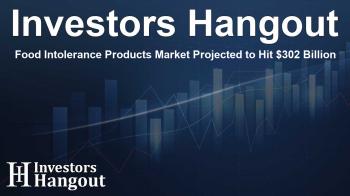Food Intolerance Products Market Projected to Hit $302 Billion

Understanding the Food Intolerance Products Market
The global food intolerance products market is experiencing significant growth, currently valued at approximately USD 85.95 billion in 2024. This market is expected to expand rapidly, reaching an impressive USD 302.26 billion by 2034, reflecting a compound annual growth rate (CAGR) of 13.4% from 2025 to 2034. This surge is largely fueled by the increasing prevalence of food allergies, particularly to gluten, lactose, and other allergens, which are becoming more recognized and diagnosed among consumers.
Factors Driving Market Growth
The rising awareness of food intolerances has led to a higher demand for products tailored to those with specific dietary needs. Many people are now aware of conditions like celiac disease, which necessitates the avoidance of gluten, and lactose intolerance, further contributing to the growth of this market. In response, manufacturers are developing a wide array of food items free from these harmful ingredients, providing healthier alternatives for affected consumers.
Market Overview: Key Highlights
The food intolerance products market is characterized by several key segments that demonstrate distinct consumer preferences:
- Regional Insights: The Asia Pacific region led the market in 2024 and is projected to maintain this lead due to its rising health awareness and increasing availability of clean-label products. Meanwhile, North America is also expected to see significant growth.
- Product Type: Dairy alternatives, particularly lactose-free products, dominated the market in 2024. Bakery items are also gaining traction as consumers seek allergen-free alternatives.
- Consumer Preferences: The demand for organic and clean-label products is on the rise, indicating a shift in consumer behavior towards healthier options.
Emerging Trends in Food Intolerance Products
One of the noteworthy trends is the shift towards convenient, ready-to-eat clean-label foods, catering to a busy lifestyle while meeting dietary restrictions. Additionally, the increasing popularity of personalized diets allows consumers to choose options that align with their health goals.
Technological advancements, including smart food packaging that ensures freshness and nutritional quality, are also playing a crucial role in enhancing the food intolerance products market. These innovations not only improve consumer experiences but also enable manufacturers to optimize production processes.
The Role of AI in Shaping the Future
Artificial intelligence is significantly transforming the food intolerance products market by enabling personalized nutrition solutions. AI can analyze various datasets, allowing companies to create tailored products that meet consumers' unique dietary needs. This includes gluten-free, lactose-free, and nut-free options that do not compromise on taste and variety.
Recent Developments in the Market
Recent advancements show a strong trend of companies innovating their product offerings. For example, Instacart has recently launched AI-powered shopping tools that help consumers find foods suitable for their dietary preferences. Additionally, PlantBaby, a food tech startup, has garnered investment to expand its plant-based milk offerings, highlighting the market's focus on healthy alternatives for children.
Challenges and Opportunities
While the food intolerance products market is thriving, challenges such as high production costs and limited consumer awareness present significant hurdles. High-quality ingredients required to produce allergen-free foods often lead to higher prices, which can deter some consumers.
Despite these challenges, opportunities abound in product innovation. Advanced food processing technologies are helping create more affordable and accessible clean-label products, catering to the growing demand from health-conscious consumers.
Regional Market Performances
The Asia Pacific region stands out as the leading market, driven by rising consumer awareness about health and wellness. The demand for allergen-free options is increasing, propelled by a sizeable population that is becoming more health-conscientious.
Conversely, North America is seeing a rapid growth trajectory. The demand for clean-label foods is rapidly gaining momentum, corresponding with a general trend of increasing health consciousness among consumers.
Frequently Asked Questions
1. What is the projected value of the food intolerance products market by 2034?
The food intolerance products market is expected to reach approximately USD 302.26 billion by 2034.
2. What factors are driving the growth of this market?
The growth is driven by the increasing prevalence of food allergies and intolerances, health awareness, and the demand for clean-label products.
3. Which regions are leading the food intolerance products market?
The Asia Pacific region led the market in 2024, with North America expected to experience significant growth in the forecast period.
4. What innovations are shaping the future of food intolerance products?
Technological advancements, such as AI and smart food packaging, are key innovations that enhance product quality and consumer satisfaction.
5. What are the main challenges facing the market?
High production costs and limited consumer awareness about food intolerances are significant challenges for the market.
About The Author
Contact Lucas Young privately here. Or send an email with ATTN: Lucas Young as the subject to contact@investorshangout.com.
About Investors Hangout
Investors Hangout is a leading online stock forum for financial discussion and learning, offering a wide range of free tools and resources. It draws in traders of all levels, who exchange market knowledge, investigate trading tactics, and keep an eye on industry developments in real time. Featuring financial articles, stock message boards, quotes, charts, company profiles, and live news updates. Through cooperative learning and a wealth of informational resources, it helps users from novices creating their first portfolios to experts honing their techniques. Join Investors Hangout today: https://investorshangout.com/
The content of this article is based on factual, publicly available information and does not represent legal, financial, or investment advice. Investors Hangout does not offer financial advice, and the author is not a licensed financial advisor. Consult a qualified advisor before making any financial or investment decisions based on this article. This article should not be considered advice to purchase, sell, or hold any securities or other investments. If any of the material provided here is inaccurate, please contact us for corrections.

